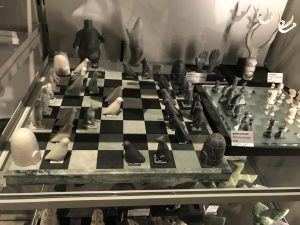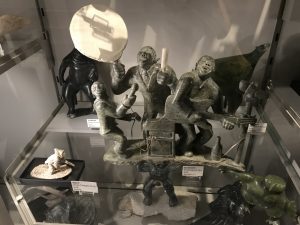Peter Morin’s ‘This Song is a Museum’ (1977) is exhibited in a glass case with top light in Multiversity Gallery in the Museum of Anthropology. This artwork consists of five drums and a drumstick, which are placed in picturesque disorder. The drumstick is heavily decorated by shiny beads on its shaft and covered with a white fur on the top. It is noticeable that the fur at the top is dipped in black paint. The drums are made of elk-skin with different shapes include round and octagonal. Various patterns are painted on them. Apparently, Morin turns the drumstick into a brush and the drums into the canvas. The splash patterns of the black paint show the strength of playing the drums. Meanwhile, it tells the artist’s emotion. I saw peaceful, excitement, brightness and mild in his work through various shapes of the paint. He reflects the pattern of life of Tahltan, which is a First Nations people group inhabiting British Columbia.

There’s a dagger of Tahltan which was strictly used for war is exhibited on the right side of the glass case. Meanwhile, clothing is also exhibited. These elements of defense, costumes and so forth constitute a more comprehensive culture of Tahltan. Artifacts which are made of black or white marble with exquisite craftsmanship are found on the left side of Morin’s work. They are labeled as representations of Inuit culture. While they share similarities with Morin’s ‘This Song is a Museum’ which is an artwork of Tahltan culture. Most of these artifacts are figures or sculptures of entertainment, such as sculptures of musical bands and chessboards. Both Inuit and Tahltan culture shows the awareness of aesthetic as well as entertainment of indigenous people. The museum curators claim that Morin’s artwork is a symbol of rich culture and a strong economic foundation. To provide evidence for it, the curators display other Tahltan exhibitions around ‘This Song is a Museum’ and shows their indigenous identity.


As a viewer, I was wondering how to formalize intangible things. A song is intangible, what makes a song? Morin gives me the idea that musical instruments are typical representations of a song. “The drums are a record of indigenous knowledge” explains by Morin. He mixes the indigenous elements into his artwork which is an outstanding example of indigenous identity. Most viewers don’t have the knowledge about the aboriginal people—Tahltan. Not everybody is familiar with the history or anthropology. However, we are familiar with the mundane musical instruments displayed in Morin’s artwork. He turns something abstract into something we familiar with.